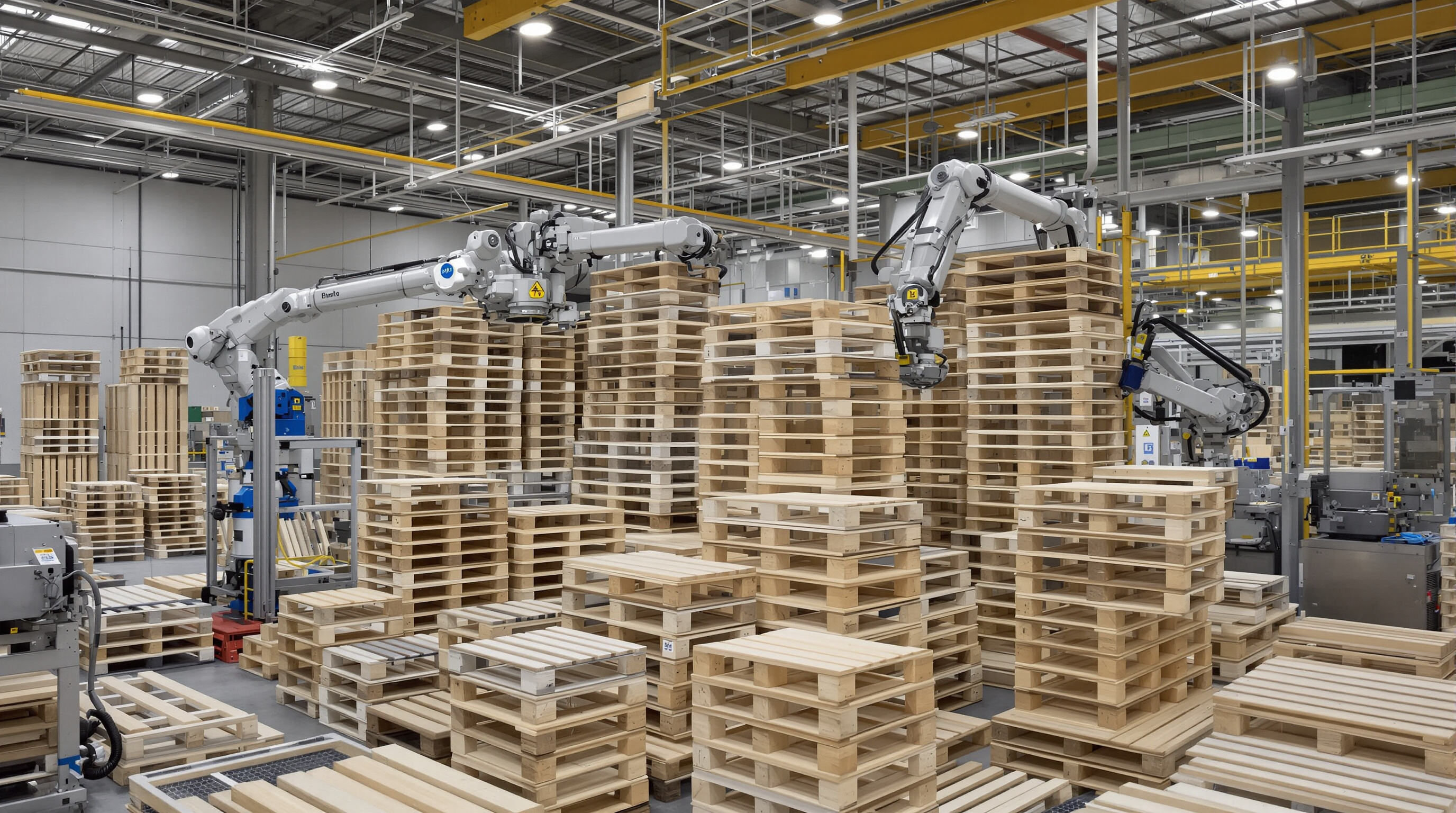How Automation Is Revolutionizing Wood Packaging Efficiency

The Role of Automation in Modern Wood Packaging Systems
The wood packaging industry is seeing major changes as robots take over tasks that used to require lots of hands-on work. Instead of workers doing all the cutting, putting things together, and stacking onto pallets, we now see machines handling these jobs. Modern equipment can sort logs and align components with incredible accuracy, sometimes down to fractions of a millimeter. This means fewer people need to be involved in big production runs, with some facilities reporting around 60% less human involvement. Industry reports from last year show something pretty interesting too: factories using automation complete their work cycles about 34% quicker than those relying on traditional methods. Plus, there are fewer mistakes overall, with defect rates dropping by roughly 22%. These numbers tell us why so many companies are investing heavily in automated solutions these days.
AI and Machine Vision for Precision Quality Control
Machine learning algorithms detect wood grain irregularities, moisture imbalances, and structural weaknesses with 99.3% accuracy—outperforming human inspectors. Vision systems analyze over 120 parameters per second during assembly, flagging defective components in real time. This capability reduces annual material waste by 18% and ensures compliance with international standards such as ISPM 15.
Smart Factories: Integrating IoT and Real-Time Data in Wood Packaging
Sensors connected to the internet track everything from when logs first arrive at the facility all the way through until they get loaded onto pallets for shipping, which helps factories adjust their production plans as market demands change. According to last year's report on automation trends in wood processing, facilities that implement these real time monitoring systems see about a 27 percent boost in how much they can actually use their equipment throughout the day. For those concerned about unexpected machine breakdowns, there are now predictive maintenance tools that analyze vibrations and heat patterns coming off CNC machines. These systems have cut down on surprise stoppages by around 41%, something that makes a huge difference in keeping production lines running smoothly without constant interruptions.
Case Study: SHANDONG HICAS MACHINERY GROUP’s Automation Success
When a major manufacturing company installed robotic sorting arms alongside AI powered quality control systems, their packaging operations saw a boost of around 33%. These machines handle approximately 12.4 items every minute while maintaining dimensional accuracy within half a millimeter, which makes all the difference when preparing products for international shipping standards. The facility has automated lifters that can move those massive 2400mm long beams weighing nearly 500 kilograms each, something that has cut down on worker injuries significantly over time, actually reducing incidents by about two thirds. Looking at energy consumption too, recent audits revealed that power usage dropped roughly 19% per pallet processed since they started optimizing how machines operate during downtime periods between tasks.
Sustainability in Wood Packaging: Aligning with Regulations and Consumer Expectations
Rising Consumer Demand for Eco-Friendly Wood Packaging Solutions
A 2025 consumer survey reveals that 73% of global shoppers prioritize sustainability when selecting packaged goods. This trend pushes manufacturers to adopt FSC-certified timber and plant-based binders. Brands combining durability with biodegradability gain a competitive edge, as 68% of consumers are willing to pay more for wood packaging with blockchain-verified sustainability claims.
Environmental Impact of Wood Packaging: A Life Cycle Perspective
Wood packaging actually produces around 40-45% less carbon compared to plastic options when responsibly sourced from forests. The catch though? Kiln drying timber still takes up a lot of energy, as does applying those chemical preservatives to protect against rot. Some new approaches are helping though. Companies experimenting with solar powered wood processing plants have seen their emissions drop by roughly a third, reports the Sustainable Packaging Coalition last year. And there's something else happening too. Many manufacturers now take leftover sawdust and turn it into useful products like biochar for soil enrichment or insulation materials, which means nothing goes to waste in the production chain anymore.
Meeting Global Regulatory Standards for Sustainable Packaging
Under the EU's new Packaging and Packaging Waste Regulation, wood packaging will need to contain at least 70% recycled material by the end of this decade. Meanwhile over in California, legislation known as SB 54 is forcing businesses to track where their timber comes from to prevent illegal logging. Many companies are responding by switching to ISO 14001 certified supply chains and bringing in outside experts for carbon accounting. Some progressive manufacturers are going even further though. They partner with reforestation groups to plant back more trees than they cut down, often restoring 120% of what gets harvested. This approach isn't just good for the environment, it actually gives them a competitive edge in today's market where customers care deeply about both following regulations and making responsible choices.
Innovative Materials and the Circular Economy in Wood Packaging

Renewable and Plant-Based Materials Enhancing Wood Packaging Sustainability
More companies in the manufacturing sector are moving away from traditional petroleum based glues towards greener options such as soy based adhesives and resins made from things left over after farming operations. According to Packaging Gateway research from last year, these eco friendly materials cut down on our reliance on oil by about 40 percent while still holding up just fine under stress tests. Looking at what's happening with packaging innovations, bamboo mixed composites along with willow wood fibers that grow quickly are showing up in nearly 30% of all recent patent applications for wooden packaging solutions. These alternatives provide real world benefits compared to conventional timber sources which take decades to mature before they can be harvested.
Designing for Circularity: Closed-Loop Systems in Wood Packaging
Modern wood packaging supports circularity through standardized connectors allowing 90% component reuse, RFID-tagged pallets tracked across 12+ lifecycles via IoT networks, and industrial symbiosis programs repurposing 650,000 tons of waste annually into biomass energy. A 2024 circular economy report shows these practices reduce virgin material consumption by 63% compared to linear models.
Environmental Benefits of Sustainable Material Innovations
Life cycle analyses confirm significant improvements from plant-based wood packaging materials:
| Metric | Improvement vs Traditional |
|---|---|
| Carbon Footprint | 54% reduction |
| Water Consumption | 38% reduction |
| Landfill Diversion Rate | 89% increase |
These advancements help manufacturers meet ISO 14001 certification requirements and align with targets set by the EU Circular Economy Package.
FAQ
How does automation impact efficiency in wood packaging?
Automation significantly enhances efficiency by reducing human involvement, accelerating work cycles by 34%, and minimizing defect rates by approximately 22%.
What role does AI play in quality control within the wood packaging industry?
AI and machine vision systems detect wood grain irregularities, moisture imbalances, and structural weaknesses with high accuracy, reducing material waste and ensuring compliance with international standards.
How are smart factories revolutionizing wood packaging production?
Smart factories utilize IoT and real-time data to enhance production adaptability, leading to a 27% increase in equipment usage and a 41% reduction in unexpected machine stoppages.
What sustainability trends are shaping consumer preferences for wood packaging?
Consumers are increasingly prioritizing sustainability, favoring products with FSC-certified timber and plant-based binders, with many willing to pay more for packaging with verified sustainability claims.
How is the wood packaging industry addressing environmental impacts?
The industry reduces carbon emissions by sourcing responsibly, experimenting with solar-powered plants, and repurposing sawdust for other uses, contributing to a more sustainable production chain.
Table of Contents
- How Automation Is Revolutionizing Wood Packaging Efficiency
- Sustainability in Wood Packaging: Aligning with Regulations and Consumer Expectations
- Innovative Materials and the Circular Economy in Wood Packaging
-
FAQ
- How does automation impact efficiency in wood packaging?
- What role does AI play in quality control within the wood packaging industry?
- How are smart factories revolutionizing wood packaging production?
- What sustainability trends are shaping consumer preferences for wood packaging?
- How is the wood packaging industry addressing environmental impacts?


